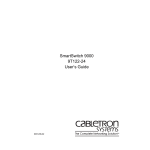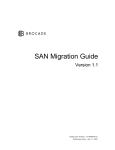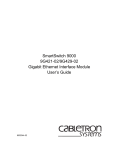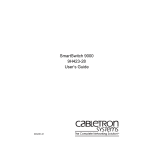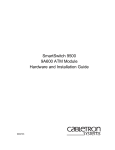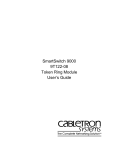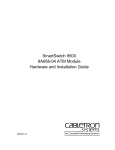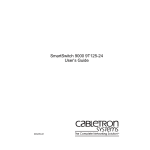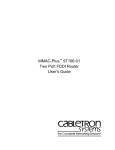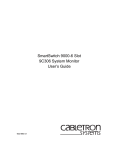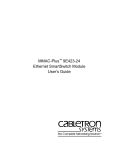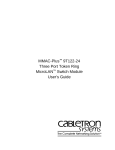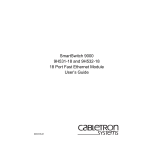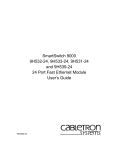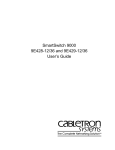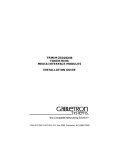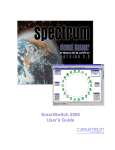Download Cabletron Systems 9T427-16 User's Manual
Transcript
SmartSwitch 9000 9T425-16, 9T427-16, and 9T428-16 Token Ring Module User’s Guide 9032172-04 Notice Notice Cabletron Systems reserves the right to make changes in speciÞcations and other information contained in this document without prior notice. The reader should in all cases consult Cabletron Systems to determine whether any such changes have been made. The hardware, Þrmware, or software described in this manual is subject to change without notice. IN NO EVENT SHALL CABLETRON SYSTEMS BE LIABLE FOR ANY INCIDENTAL, INDIRECT, SPECIAL, OR CONSEQUENTIAL DAMAGES WHATSOEVER (INCLUDING BUT NOT LIMITED TO LOST PROFITS) ARISING OUT OF OR RELATED TO THIS MANUAL OR THE INFORMATION CONTAINED IN IT, EVEN IF CABLETRON SYSTEMS HAS BEEN ADVISED OF, KNOWN, OR SHOULD HAVE KNOWN, THE POSSIBILITY OF SUCH DAMAGES. © Copyright December 1999 by: Cabletron Systems, Inc. P.O. Box 5005 Rochester, NH 03866-5005 All Rights Reserved Printed in the United States of America Order Number: 9032172-04 SPECTRUM and LANVIEW are registered trademarks and MicroLAN and SmartSwitch 9000 are trademarks of Cabletron Systems, Inc. i Notice FCC Notice This device complies with Part 15 of the FCC rules. Operation is subject to the following two conditions: (1) this device may not cause harmful interference, and (2) this device must accept any interference received, including interference that may cause undesired operation. NOTE: This equipment has been tested and found to comply with the limits for a Class A digital device, pursuant to Part 15 of the FCC rules. These limits are designed to provide reasonable protection against harmful interference when the equipment is operated in a commercial environment. This equipment uses, generates, and can radiate radio frequency energy and if not installed in accordance with the operatorÕs manual, may cause harmful interference to radio communications. Operation of this equipment in a residential area is likely to cause interference in which case the user will be required to correct the interference at his own expense. WARNING: Changes or modiÞcations made to this device which are not expressly approved by the party responsible for compliance could void the userÕs authority to operate the equipment. VCCI Notice This is a Class A product based on the standard of the Voluntary Control Council for Interference by Information Technology Equipment (VCCI). If this equipment is used in a domestic environment, radio disturbance may arise. When such trouble occurs, the user may be required to take corrective actions. DOC Notice This digital apparatus does not exceed the Class A limits for radio noise emissions from digital apparatus set out in the Radio Interference Regulations of the Canadian Department of Communications. Le prŽsent appareil numŽrique nÕŽmet pas de bruits radioŽlectriques dŽpassant les limites applicables aux appareils numŽriques de la class A prescrites dans le R•glement sur le brouillage radioŽlectrique ŽdictŽ par le minist•re des Communications du Canada. ii Notice DECLARATION OF CONFORMITY Application of Council Directive(s): Manufacturer’s Name: Manufacturer’s Address: European Representative Name: European Representative Address: Conformance to Directive(s)/Product Standards: Equipment Type/Environment: 89/336/EEC 73/23/EEC Cabletron Systems, Inc. 35 Industrial Way PO Box 5005 Rochester, NH 03867 Mr. J. Solari Cabletron Systems Limited Nexus House, Newbury Business Park London Road, Newbury Berkshire RG13 2PZ, England EC Directive 89/336/EEC EC Directive 73/23/EEC EN 55022 EN 50082-1 EN 60950 Networking Equipment, for use in a Commercial or Light Industrial Environment. We the undersigned, hereby declare, under our sole responsibility, that the equipment packaged with this notice conforms to the above directives. Manufacturer Legal Representative in Europe Mr. Ronald Fotino ________________________________________ Mr. J. Solari ________________________________________ Full Name Full Name Principal Compliance Engineer ________________________________________ Managing Director - E.M.E.A. ________________________________________ Title Title Rochester, NH, USA ________________________________________ Location Newbury, Berkshire, England ________________________________________ Location iii Notice iv Contents Chapter 1 Introduction Features........................................................................................................................... 1-1 Related Manuals............................................................................................................ 1-4 Getting Help .................................................................................................................. 1-5 Chapter 2 Installation Installing the SmartSwitch 9000 Module................................................................... 2-1 The Reset Switch ........................................................................................................... 2-3 Setting the Module Card DIP Switch ......................................................................... 2-4 Front Panel Cabling ...................................................................................................... 2-6 The 9T425-16 and 9T427-16 Modules.................................................................. 2-6 Station Port Pins.............................................................................................. 2-6 Lobe Port Pins ................................................................................................. 2-7 The 9T428-16 Module ............................................................................................ 2-7 Recommended Cable Lengths .................................................................................... 2-8 Defaults......................................................................................................................... 2-10 Chapter 3 Operation TNIB ................................................................................................................................ 3-2 Switching........................................................................................................................ 3-3 Transparent Switching.................................................................................................. 3-3 Source Route and Source Route Translational Switching ....................................... 3-4 Spanning Tree Algorithm - IEEE 802.1d .................................................................... 3-4 System Management Buses ......................................................................................... 3-5 SMB-1 Bus ............................................................................................................... 3-5 SMB-10 Bus ............................................................................................................. 3-5 System Diagnostic Controller...................................................................................... 3-6 DC/DC Converter ........................................................................................................ 3-6 INB NIB .......................................................................................................................... 3-6 SecureFast Switch.......................................................................................................... 3-6 i960 Core......................................................................................................................... 3-7 Chapter 4 LANVIEW LEDs v Notice Chapter 5 Specifications Safety............................................................................................................................... 5-1 Service ............................................................................................................................. 5-1 Physical ........................................................................................................................... 5-2 Dimensions ............................................................................................................. 5-2 Weight ...................................................................................................................... 5-2 Electrical ......................................................................................................................... 5-2 Standards........................................................................................................................ 5-2 Port Interfaces ................................................................................................................ 5-2 vi Chapter 1 Introduction The 9T425-16, 9T427-16, and 9T428-16 Token Ring SmartSwitch 9000ª Modules are Enterprise Backbone switches supporting Smart Networking Services, RMON per port and Dedicated Token Ring. The 9T425-16, 9T427-16, and 9T428-16 modules (shown in Figure 1-1) provide sixteen ports, either UTP or STP for the 9T425-16 and 9T427-16, or multimode Þber for the 9T428-16. Combined with its connection to the INB2 backplane, this provides for up to 112 or 224 separate Token Ring segments to be interconnected within a single SmartSwitch 9000 chassis. Features Processor The 9T425-16, 9T427-16, and 9T428-16 are equipped with an advanced Intel i960 microprocessor. This microprocessor provides a platform for all management functions within a scalable RISC-based architecture. SmartSwitch 9000 ASIC – Distributed Switching These modules provide the fastest Switching fabric available at 750 Kpps. Each module contains its own switch fabric - eliminating central board Single Point of Failure. System Management As with most SmartSwitch 9000 modules, the 9T425-16, 9T427-16, and 9T428-16 interface to the two System Management Buses (SMB-1 and SMB-10) for intermodule management. Connectivity The 9T425-16, 9T427-16, and 9T428-16 provide sixteen front panel C-ports, allowing direct station attachment or station emulation for hub connections. STP and UTP cables are supported by the 9T425-16 and 9T427-16, and multimode Þber is supported by the 9T428-16. 1-1 Introduction TOKEN RING 9T427-16 TX STN 1 RX Mb/s TX STN 2 RX Mb/s TX STN 3 RX Mb/s TX STN 4 RX Mb/s TX STN 5 RX Mb/s TX STN 6 RX Mb/s TX STN 7 RX Mb/s TX STN 8 RX Mb/s TX STN 9 RX Mb/s TX STN 10 RX Mb/s TX STN 11 RX Mb/s TX STN 12 RX Mb/s TX STN 13 RX Mb/s TX STN 14 RX Mb/s TX STN 15 RX Mb/s TX STN 16 RX Mb/s STN Mb/s LED MODE Figure 1-1. The 9T425-16, 9T427-16, and 9T428-16 SmartSwitch 9000 Modules 1-2 Introduction Packet Switching Packet Switching occurs between the front panel Token Ring connections and/or to any other module in the chassis via the INB2 bus. These modules are capable of Transparent Bridging or Source Route Translational Bridging. IEEE 802.1d Spanning Tree Protocol is supported in all bridging functions. Source Route Translational Switching Allows both transparent (TP) and Source Route (SR) packets to be forwarded. SR packets are translated to TP; the Route Information Field (RIF) is stripped and cached on each front panel port inbound SR. Outbound packets are automatically reverse-translated by appending RIF data from the RIF cache into the packets before transmission. Management Information Base (MIB) Support The 9T425-16, 9T427-16, and 9T428-16 modules provide MIB support including: ¥ ¥ ¥ ¥ ¥ ¥ IETF MIB II (RFC 1213) IETF RMON MIB (RFC 1757 and 1513) IETF Bridge MIBs (RFC 1493 and 1525) IEEE 802.5 Token Ring MIB (RFC 1748) IEEE DTR MAC MIB Cabletron Enterprise MIBs For a complete list of supported MIBs, refer to the release notes provided in the module package. NOTE LANVIEW LEDs The 9T425-16, 9T427-16, and 9T428-16 use LANVIEW Ð the Cabletron Systems built-in visual diagnostic and status monitoring system. With LANVIEW LEDs, you can quickly identify the device, port, and physical layer status at a glance. Hot Swapping The 9T425-16, 9T427-16, and 9T428-16 can be installed or removed from the chassis while the SmartSwitch 9000 is powered up without affecting the operation of the remaining modules in the chassis. RMON Five RMON groups are supported in the 9T425-16, 9T427-16, and 9T428-16: Statistics, History, Alarms, Events, and Token Ring. Broadcast Thresholds The 9T425-16, 9T427-16, and 9T428-16 contain broadcasts in the event of a broadcast storm. 1-3 Introduction SFVLAN (SecureFast Virtual LANS) The 9T425-16, 9T427-16, and 9T428-16 allow connection-orientated Switched Virtual Circuits (SVC). Protocol Translations The 9T425-16, 9T427-16, and 9T428-16 allow Òany-to-anyÓ connectivity for IPX, IP, SNA, Netbios, Appletalk protocols between Token Ring and Ethernet, FDDI, and Fast Ethernet devices. Dedicated Token Ring - Auto TXI or TKP Modes The 9T425-16, 9T427-16, and 9T428-16 can operate in either TXI (Transmit Immediate, a.k.a. Full Duplex) or TKP (Token Passing, a.k.a. Standard) modes. TXI is tried Þrst. If this is incompatible with other products on the ring, TKP mode is used. Auto MTU Size If the user changes the ring speed, The MTU is automatically set to the maximum size for that speed. The maximum allowable MTU is 8130 bytes @16 Mbps or 4500 bytes @4 Mbps. The user may set the MTU to a smaller size, if desired. Auto Ring Number Detection The 9T425-16, 9T427-16, and 9T428-16 set the Ring Number automatically to match the current number in use on the ring segment. (May be toggled off. The default setting is enabled.) Related Manuals The manuals listed below should be used to supplement the procedures and technical data contained in this manual. SmartSwitch 9000 Installation Guide SmartSwitch 9000 Operations Guide SmartSwitch 9000 9C300-1 Environmental Module UserÕs Guide SmartSwitch 9000 9C214-1 AC Power Supply UserÕs Guide SmartSwitch 9000 Local Management UserÕs Guide 1-4 Introduction Getting Help For additional support related to this device or document, contact Cabletron Systems using one of the following methods: World Wide Web http://www.cabletron.com/ Phone (603) 332-9400 Internet mail [email protected] FTP ftp://ftp.cabletron.com/ anonymous your email address Login Password To send comments or suggestions concerning this document, contact the Cabletron Systems Technical Writing Department via the following email address: [email protected] Make sure to include the document Part Number in the email message. Before calling Cabletron Systems, have the following information ready: ¥ Your Cabletron Systems service contract number ¥ A description of the failure ¥ A description of any action(s) already taken to resolve the problem (e.g., changing mode switches, rebooting the unit, etc.) ¥ The serial and revision numbers of all involved Cabletron Systems products in the network ¥ A description of your network environment (layout, cable type, etc.) ¥ Network load and frame size at the time of trouble (if known) ¥ The device history (i.e., have you returned the device before, is this a recurring problem, etc.) ¥ Any previous Return Material Authorization (RMA) numbers 1-5 Introduction 1-6 Chapter 2 Installation Installing the SmartSwitch 9000 Module The SmartSwitch 9000 module may be installed into any two available slots. To install, follow the steps below: NOTE The INB Terminator Modules must be installed on the rear of the fourteen slot chassis before powering up this module. The INB Terminator Modules are not required on the six slot chassis. Refer to the INB Terminator Modules Installation Guide for information and installation procedure. 1. Remove the blank panels covering the slots that the module is being mounted in. All other slots must be covered if modules are not being installed, to ensure proper airßow and cooling. 2. Carefully remove the module from the shipping box. (Save the box and packing materials in the event the module must be reshipped.) 3. Attach one end of the ESD wrist strap packaged with the SmartSwitch 9000 chassis to your wrist. Plug the other end into the ESD Wrist Strap Grounding receptacle in the lower right corner of the SmartSwitch 9000 Chassis shown in Figure 2-1. 4. Remove the module from the plastic bag. Observe all precautions to prevent damage from Electrostatic Discharge (ESD). 5. Carefully examine the module, checking for shipping damage. If any damage exists, DO NOT install the module. Contact Cabletron Systems Technical Support immediately. 6. The module is installed into the chassis by sliding it into a pair of slots and locking down both pairs of top and bottom plastic tabs, as shown in Figure 2-1. Take care that the module slides in straight and engages the backplane connectors properly. Ensure that both circuit cards are between the card guides. Check both the upper and lower tracks of both cards. 2-1 Installation 7 KLF N 8 KLF N KLF N 10 RX KLF N N SI TX 11 RX KLF N N SI TX 12 RX Receptacle for ESD wrist strap Metal Back-Panel Circuit Card Card Guides Warning: Ensure that the circuit card is between the card guides. Lock down the top and bottom plastic tabs at the same time, applying even pressure. Figure 2-1. Installing the SmartSwitch 9000 Module 2-2 Installation The Reset Switch The Reset switch is located on the front panel, under the top plastic tab as shown in Figure 2-2. It serves two functions: ¥ ¥ Pressing the reset switch twice within three seconds causes the processor (i960) to reset. Pressing and holding the switch for three or more seconds causes the module to shutdown. Pressing and holding the switch again for three seconds restarts the module. SNMP management may be used to disable this switch to enhance module security. Reset Switch SMB CPU Figure 2-2. The Reset Switch 2-3 Installation Setting the Module Card DIP Switch An eight position DIP switch is located just under the edge of the top module card as shown in Figure 2-3. The functions of the switch are listed in Table 2-1. 1 2 3 4 5 6 7 8 Figure 2-3. Location of Module DIP Switch 2-4 Installation See the Cautions at the end of this table. Table 2-1. Functions of DIP Switch Switch Function Description 8 Clear Password 1 When toggled, this switch clears user-entered passwords stored in NVRAM, and restores the default passwords. Once reset you can use the defaults or enter new passwords. 7 Clear NVRAM 2 The module uses NVRAM to store userentered parameters such as IP addresses, device name, etc. To reset these parameters to the factory defaults, toggle this switch. Once reset, you can use the defaults or enter new parameters which are stored in NVRAM when the module is powered down, and remain there until the switch is toggled again. 6 Force BootP Download Toggling this switch after pulling the board out of the SmartSwitch 9000, clears download information from NVRAM and forces image Þles to be downloaded from the station conÞgured to act as that modulesÕ BOOTP server. 5 Reserved For Factory Use Only (Factory Default is OFF) 4 Reserved For Factory Use Only (Factory Default is OFF) 3 Reserved For Factory Use Only (Factory Default is OFF) 2 Reserved For Factory Use Only (Factory Default is OFF) 1 Reserved For Factory Use Only (Factory Default is OFF) 1 ! CAUTION Do not toggle Switch 8 unless you intend to reset the user-conÞgured passwords to their factory default settings. 2 Do not toggle Switch 7 unless you intend to reset the user parameters to the factory default settings. 2-5 Installation Front Panel Cabling This section details the front panel cabling for the 9T425-16, 9T427-16, and 9T428-16 modules. The 9T425-16 and 9T427-16 Modules This section shows the pin-outs for wiring cable to the front panel RJ45 connectors. Station Port Pins Figure 2-4 illustrates the signal assignments for RJ45 station port pins. Cable Shield 1 2 3 4 5 6 TxRx+ RxTx+ 7 8 Cable Shield Figure 2-4. RJ45 Station Port Pins – Signal Assignments 2-6 Installation Lobe Port Pins Figure 2-5 illustrates the signal assignments for RJ45 lobe port pins. Cable Shield 1 2 RxTx+ TxRx+ 3 4 5 6 7 8 Cable Shield Figure 2-5. RJ45 Lobe Port Pins – Signal Assignments The 9T428-16 Module Table 2-2 lists signal tolerance speciÞcations for the Multimode Fiber Optic cable used for front panel connections. Table 2-2. Signal Tolerances for Multimode Fiber Optic Cable Cable Type Attenuation Maximum Drive Distance Multimode 50/125 µm ≤ 13.0 dB 2 km (2187.7 yards) Multimode 62.5/125 µm ≤ 16.0 dB 2 km (2187.7 yards) Multimode 100/140 µm ≤ 19.0 dB 2 km (2187.7 yards) Typical Signal Attenuation Rate: ≤ 1.5 dB/km The Fiber Optic cable segments have ST connectors. They are connected by inserting the connector in the port and then turning it to lock down. The Receive port of one device is connected to the Transmit port of the other device as shown in Figure 2-6. 2-7 Installation TX Port To TX Port on Other Ring To RX Port on Other Ring RX Port Figure 2-6. Connecting Fiber Optic cable to the 9T428-16 Recommended Cable Lengths The IEEE 802.5 speciÞcation does not specify a minimum lobe length in meters that a Token Ring station must meet. Rather the standard speciÞes Cable Attenuation, Signal to Crosstalk Noise Ratio (SCNR) and a Next Loss to Insertion Loss Ratio (NIR) which must be met. This method of speciÞcation allows maximum ßexibility when constructing a cabling system, however it can be very complicated to the end user unfamiliar with these terms. Therefore the following cabling guidelines are recommended. These recommendations are conservative to provide a problem free environment to the end user. Longer lengths are achievable with good cable plants. Table 2-3 and Table 2-4 list the recommended cable lengths for Station cables. Table 2-5 lists the recommended cable lengths for Lobe cables. 2-8 Installation Table 2-3. 16 MBPS (Station Mode) - 9T425-16/9T427-16 Passive MAU (meters) Cable Type Active MAU (meters) Category 3 UTP 55 100 Category 4/5 UTP 100 180 Type 1 STP 200 300 Table 2-4. 4 MBPS (Station Mode) - 9T425-16/9T427-16 Passive MAU (meters) Cable Type Active MAU (meters) Category 3 UTP 150 250 Category 4/5 UTP 250 350 Type 1 STP 300 500 Table 2-5. DTR (LOBE PORT Mode) - 9T425-16/9T427-16 Cable Type 4 MBPS (meters) 16 MBPS (meters) Category 3 UTP 250 100 Category 4/5 UTP 350 250 Type 1 STP 600 500 Table 2-6. Multimode Fiber Optic Cable - 9T428-16 Cable Type 4 MBPS (km) 16 MBPS (km) Multimode 50/125 µm 2 2 Multimode 62.5/125 µm 2 2 Multimode 100/140 µm 2 2 2-9 Installation Defaults When the module is installed, the parameters listed below are the defaults. These can be changed by Local Management or by SNMP management. Ring Speed (or Media Rate) Defaults to a 16Mbps ring speed. Ring Numbers Default to the Token Ring port number (i.e., port 3 = ring number 3). If ÒAuto-Detect Ring NumberÓ is enabled and a RPS device is present, the ring number will be set to the existing number in use on the attached ring segment. Source Route Bridge Number Defaults to one. Virtual Ring Number All ports are switched to an internal virtual ring. The number defaults to CAC. C-Port Mode Defaults to STN/RI for the 9T428-16 module. The 9T425-16 and 9T427-16 default to AUTO - it automatically determines STN or LOBE when the cable is attached. Bridge Type/Explorer Type Defaults to TP/TP. This setting allows the port to receive Source Route and Transparent frames, but transmits all frames to the ring segment connected to the front panel as Transparent frames (TP). Unknown and broadcast (Explorers) are also transmitted as transparent (TP) frames. 2-10 Chapter 3 Operation The 9T425-16, 9T427-16, and 9T428-16 SmartSwitch 9000 Modules provide connectivity between the front panel Token Rings and the INB2 backplane. SmartSwitch 9000 modules connect to either the Internal Network Bus (INB) or the Flexible Network Bus (FNB) bus. The 9T425-16, 9T427-16, and 9T428-16 modules connect only to the INB2 bus. Switching may occur between the sixteen front panel ports and/or to any other SmartSwitch 9000 module via the INB2 Bus. As shown in the block diagram in Figure 3-1, the Token Ring Network Interface Blocks (TNIBs) convert data packets received from any of the ports into a canonical frame format before forwarding to the SmartSwitch 9000 ASIC, while the Internal Network Bus Network Interface Block (INB NIB) converts data cells received from the INB into a canonical format before forwarding to the SmartSwitch 9000 ASIC. 3-1 Operation SMB 1 i960 Processor Diagnostic Controller SMB 10 DC/DC Convertor TNIB 1 TNIB Smart Switch ASIC I N B INB NIB 2 TNIB TNIB Figure 3-1. 9T425-16, 9T427-16, and 9T428-16 Block Diagram All data packets destined for a front panel port, the INB, or the i960 are converted into the canonical format before forwarding to the SmartSwitch 9000 ASIC. Network Interface Blocks (NIBs) check for valid data packets entering the system. If an errored data packet is found, the SmartSwitch 9000 ASIC ßags the error and does not forward the errored data packet to any outbound ports. Once in this common format, the SmartSwitch 9000 ASIC decides from header information the port destination of data packets. Data packets are then converted from the canonical format to the proper format for the interface destination whether it is a front panel port, or connection to the INB. TNIB The Token Ring Network Interface Block (TNIB) converts Token Ring data packets received through front panel ports into a common canonical format that allows the SmartSwitch 9000 ASIC Engine to determine the proper destination port. The TNIB also converts data packets from the common canonical format back to Token Ring packets for transmission out front panel ports. 3-2 Operation Switching The 9T425-16, 9T427-16, and 9T428-16 operate as a Source Route Translational (SR-TB) switch. They provide translation to transparent frames. For information on conÞguring the switching function, see the addendum to the SmartSwitch 9000 Local Management UserÕs Guide, containing information speciÞc to this model. All SR (Source Route) and TP (Transparent) frames are translated to canonical frames (even between ports on the front panel). The RIFs (Routing Information Field) of SR frames are cached on each port. In Traditional Bridging mode, all canonical frames are forwarded based on a destination address. RIF information is not used in the decision to forward frames. The Token Ring ports on the 9T425-16, 9T427-16, and 9T428-16 are conÞgurable for three modes of operation: TP (Transparent) - ports receive Source Route and Transparent frames but transmit only packets that are Transparent. SR (Source Routing) - ports receive and transmit only packets that are Source Route. SRT (Source Route and Transparent) - ports receive and transmit both Source Route and Transparent packets. Transparent Switching Transparent Switching is accomplished by building a Source Address Table (SAT) from source MAC/physical addresses and using the SAT to make forwarding decisions. The 9T425-16, 9T427-16, and 9T428-16 prevent unnecessary network trafÞc from passing through the module by implementing the IEEE 802.1d Þltering process. The IEEE 802.1d Þltering process, begins with the creation of a list of local node addresses in a table (the SAT). When the 9T425-16, 9T427-16, and 9T428-16 Þrst go on-line, they initially forward all packets across the bridge. After receiving a packet on the bridge port, the 9T425-16, 9T427-16, and 9T428-16 learn the address of the sending node from the packet and stores that address in the SAT. In this manner, the bridge learns the address of each node on each side of the bridge. The bridge then uses the addresses stored in the table to compare the destination address of each subsequent packet that travels to the bridge. If the destination address of a packet resides on the bridge segment, the 9T425-16, 9T427-16, and 9T428-16 does not forward across the Token Ring link. 3-3 Operation Source Route and Source Route Translational Switching In SR (Source Routing) and SRT (Source Route and Transparent) modes, the received SR packets are stripped of their RIF during the translation to canonical frame format. Packets that are queued for transmission out the Token Ring port can have a RIF inserted from the RIF cache, or can be sent without the RIF as a TP packet. This decision is automated when the port is set to SRT and is handled on a packet by packet basis. SRT Switching operates much the same as TP Switching, but strips the RIFs and caches them locally. Frames transmitted out the Token Ring ports have RIFs appended to them from the cache. SR operates by transmitting frames over a designated route. Unlike Transparent Bridging, all devices in a Source Route Bridged (SRB) network ÒknowÓ the locations of other stations within the network. Using the RIF portion of the MAC frame header, the source device determines the route for the frames it sends. In order for source routing to work, the source station must determine the proper route to reach the desired destination. To accomplish this: 1. The source station sends out frames called All Route Explorer (ARE) or Spanning Tree Explorer (STE) frames onto the network. All Source Route Bridges recognize these frames and forwards them to their outbound ports. 2. The receiving bridges insert their own route information to the RIF in the MAC frame header and transmit the frame again. 3. Eventually, the original source device receives all of the ARE replies from the other end stations on the network. 4. From this information, the source device can determine a desired route for each frame it transmits. Spanning Tree Algorithm - IEEE 802.1d The 9T425-16, 9T427-16, and 9T428-16 promote maximum network use in multiple bridge environments. A bridge learns the bridge topology of its network from bridge protocol data that it receives from other bridges within the network. The bridges then apply the Spanning Tree Algorithm (STA) to select a root bridge, and then determine primary data paths within potential data loop conÞgurations. BPDUs that are transmitted by the TR ports are sent to the bridge-group address in MSB format (0X800143000000). 3-4 Operation Spanning Tree Algorithm is a hierarchy (or tree) of priorities that bridges establish between themselves. This hierarchy guarantees that primary and redundant data paths are clearly deÞned at all times, so that the network is continuously available to users. In a multiple bridge environment, one bridge in the network establishes itself as the root bridge. As the root, this bridge has priority over all other bridges. In a Spanning Tree, all of the bridges must determine which bridge is the root, and then determine their own relative priority within the network. System Management Buses There are two management channels within the SmartSwitch 9000 system: the SMB-1 and the SMB-10. These buses provide out-of-band management and inter-module management communication. SMB-1 Bus The SMB-1 is a 1Mbs management bus located within the SmartSwitch 9000. This bus is utilized by all diagnostic controllers in the system including connectivity modules, power supply modules, and the environmental module. The SMB-1 transports inter-chassis information between system components, such as power and environmental information, as well as diagnostic messages. Periodic loop-back tests are performed by all modules which share this bus to ensure the validity of SMB-1. In the event a failure is detected on SMB-1, the SMB-10 may be used as an alternate communication channel. SMB-10 Bus The SMB-10 is a 10Mbs management bus located within the SmartSwitch 9000 which is also used for inter-chassis communication of modules as well as serving as an out-of-band management channel into the SmartSwitch 9000. The SMB-10 is externalized from the chassis via an optional Ethernet Port Interface Module (EPIM) located on the front of the Environmental Module. Through an EPIM connection, full SNMP management of the SmartSwitch 9000 is available out-ofband from user data. Modules which share the SMB-10 bus periodically send out loop-back packets to ensure the validity of SMB-10. In the event a fault is detected on the SMB-10, the SMB-1 can be used as an alternate communication channel by the modules. 3-5 Operation System Diagnostic Controller This diagnostic controller is composed of a Z-80 microprocessor and its supporting logic. The diagnostic controller is designed to control the power-up sequencing of modules, monitor the 9T425-16, 9T427-16, and 9T428-16 input and output power parameters, keep watch over the main host processor, as well as monitor the temperature and control the SMB LANVIEW diagnostic LED. Although the diagnostic controller and the main host processor can operate independent of each other if needed, they exchange information about each otherÕs status and overall module condition. The information gathered by the diagnostic controller is available to the network manager via local/remote management and the LCD located on the environment module. The 9T425-16, 9T427-16, and 9T428-16 have been designed so that in the event of a diagnostic controller fault, the modules will continue to function. DC/DC Converter The DC/DC converter converts the 48 VDC on the system power bus to the necessary operating voltages for its host network services module. The diagnostic controller controls the operation of the DC/DC converter. INB NIB Each module that attaches to the Internal Network Bus (INB) has an INB Network Interface Block (NIB). The INB NIB converts canonical frames to Þxed length data blocks for transmission onto the INB. For data blocks received from the INB, the INB NIB reassembles the data blocks received from the INB back into canonical frames for transmission to the SmartSwitch 9000 ASIC then from the SmartSwitch 9000 ASIC to the front panel ports. SecureFast Switch The SmartSwitch 9000 ASIC is a hardware based switch design that is the key building block of the SmartSwitch 9000. All Þltering/forwarding decisions are made in hardware as opposed to software as in traditional switches. This custom hardware allows the SmartSwitch 9000 ASIC to process over 750K frames per second. The SmartSwitch 9000 ASIC is designed to support up to 64 ports that are shared between the host processor, the INB backplane, and LAN/WAN interfaces on the front panel of SmartSwitch 9000 modules. The SmartSwitch 9000 ASIC can operate in two modes: as a traditional switch, or as a SecureFast Switch (SFS). When operating in traditional switch mode, it makes Þltering/forwarding decisions based on Destination Address (DA), with standard IEEE 802.1d 3-6 Operation learning. When operating in SecureFast Switch mode, all Þltering/forwarding decisions are made based on a DA-SA pair and its receive port. The SmartSwitch 9000 hub can support modules operating in traditional switch mode and SecureFast Switch mode simultaneously. This provides security when-and-where needed, and ease-of-conÞguration where security is not required. i960 Core The i960 core provides the SNMP protocol stacks to support industry standard MIBs. Additionally, Cabletron enterprise extension MIBs are supported for each media type. Advanced management services, such as the Distributed LAN Monitor, telnet and network address to MAC address mapping, are also provided by the i960 core. The Host Engine sends and receives packets via the CPU SmartSwitch 9000 ASIC Interface. This allows the traditional switch to perform spanning tree protocol and other traditional switching functions. The SMB Interfaces provide communication to the Host Engine for management functions and communication with other modules in the chassis. 3-7 Operation 3-8 Chapter 4 LANVIEW LEDs The front panel LANVIEW LEDs, shown in Figure 4-1, indicate the status of the module and may be used as an aid in troubleshooting. Token Ring Port Transmit TOKEN RING System Status Token Ring Port Receive INB Transmit SMB Station Mode CPU INB INB Receive STN Mb/s 9T425-16 Port Mode Port Speed Mode Mb/s 9T428-16 Figure 4-1. LANVIEW LEDs 4-1 LANVIEW LEDs The 9T427-16 also has a front panel mode switch, shown in Figure 4-2, that changes the functions of the LEDs. TOKEN RING 9T427-16 System Status INB Transmit INB Receive TX STN 1 RX Mb/s TX STN 2 RX Mb/s TX STN 3 RX Mb/s TX STN 4 RX Mb/s TX STN 5 Transmit (TX) RX Mb/s STN TX STN 6 Receive (RX) RX Mb/s TX STN Mb/s A (Mode Switch in LEFT Position) 7 RX Mb/s TX STN 8 RX Mb/s STN TX STN STN 9 Mb/s (Speed Status) RX Mb/s TX STN 10 RX Mb/s Mb/s B (Mode Switch in RIGHT Position) TX STN 11 RX Mb/s TX STN 12 A LED functions when LED MODE switch is in the RX-TX position. This is the default switch setting. B LED functions when LED MODE switch is in the STN-Mb/s position. RX Mb/s TX STN 13 RX Mb/s TX STN 14 RX Mb/s TX STN 15 RX Mb/s TX STN 16 RX Mb/s STN LED Mode Switch Mb/s LED MODE Figure 4-2. 9T427-16 LEDs and Mode Switch 4-2 LANVIEW LEDs The functions of the two System Status LEDs, System Management Bus (SMB) and the CPU, are listed in Table 4-1. Table 4-1. System Status LEDs (SMB and CPU) LED Color State Description Green Functional Fully operational. Yellow (Flashing) Crippled Not fully operational (i.e., one bad port). Yellow/Green Booting Blinks yellow and green while booting. Red Reset Normal power-up reset. Red (Flashing) Failed Fatal error has occurred. Off Power off Module powered off. The functions of the INB receive LED are listed in Table 4-2. Table 4-2. INB Receive LED LED Color State Red No link Green (Flashing) Link, Port Disabled Green Link, No activity Yellow (Flashing) Link, Port Enabled, Activity The functions of the INB transmit LED are listed in Table 4-3. Table 4-3. INB Transmit LED LED Color State Red No Link Green (Flashing) Link, Port Enabled, Activity Yellow (Flashing) Link, Bridge Standby Off Link, No activity 4-3 LANVIEW LEDs The functions of the Token Ring Port receive LEDs are listed in Table 4-4. Table 4-4. Token Ring Receive LEDs LED Color State Green Insert, No activity, Port Enabled Yellow (Flashing) Insert, Activity, Port Enabled (Flashing rate indicates rate of activity) Off No Insert, No activity The functions of the Token Ring Port transmit LEDs are listed in Table 4-5. Table 4-5. Token Ring Transmit LEDs LED Color State Red (Flashing) Fault or Error. Ring is Beaconing Green (Flashing) Activity (Flashing rate indicates rate of activity). Yellow (Flashing) Port in standby state Off No activity The functions of the Station Mode LEDs are listed in Table 4-6. Table 4-6. Station Mode (STN) LEDs (9T425-16 & 9T427-16) LED Color 4-4 State Green Port ConÞgured for Station Emulation (Default) Off Port ConÞgured as a Lobe (TCU) Port for DirectAttach Station Connections LANVIEW LEDs Table 4-7. Mode LEDs (9T428-16 Only) LED Color State Green Port is ConÞgured as Station Emulation (STN) or Ring In (RI) (default) using 802.5 keying. Yellow Port is ConÞgured as Cabletron Ring In/Ring Out (RI/RO) using Cabletron keying. Off Port is ConÞgured as Lobe Port (Trunk Coupling Unit TCU) using 802.5 keying. The Port Speed LEDs show a combination of Ring Speed and Access Protocol in use. The functions of the Port speed LEDs are listed in Table 4-8. Table 4-8. Port Speed LEDs State* LED Color * Green 16Mbs, TXI (32M/s) Yellow (Flashing) 4 Mbs, TXI (8Mb/s) Yellow 16 Mbs, TKP Off 4 Mbs, TKP TXI is Transmit Immediate or Full Duplex operation. TKP is Token Passing or standard Token Ring. 4-5 LANVIEW LEDs 4-6 Chapter 5 Specifications Safety ! CAUTION It is the responsibility of the person who sells the system to which the module will be a part to ensure that the total system meets allowed limits of conducted and radiated emissions. This equipment meets the safety requirements of: ¥ ¥ ¥ ¥ ¥ ¥ ¥ ¥ UL 1950 CSA C22.2 No. 950 EN 60950 IEC 950 EMI Requirements of FCC Part 15 Class A EN 55022 Class A VCCI Class I EMC requirements of: EN 50082-1 IEC 801-2 ESD IEC 801-3 Radiated susceptibility IEC 801-4 EFT Service MTBF (MHBK-217E) >200,000 hrs. MTTR <0.5 hr. 5-1 Specifications Physical Dimensions 35.0 D x 44.0 H x 6.0 W centimeters (13.8 D x 17.4 H x 2.4 W inches) Weight Unit: 1.4kg. (3lb) 9T427-16 2.7kgs. (6lbs.) 9T425-16 & 9T428-16 Shipping: 1.81kg. (4lbs.) 9T427-16 3.6kgs. (8lbs.) 9T425-16 & 9T428-16 Electrical CPU: i960 Local DRAM Memory: 20Mb (expandable to 48Mb) Flash: 4Mb (expandable to 8Mb) Token Ring Interfaces: 16 Cabletron Token Ring Controllers Packet Buffer Memory: 2MB shared plus 64KB per port NVRAM: 128 Kb Standards IEEE 802.5r Dedicated Token Ring (DTR) IEEE 802.1d Transparent Bridging Port Interfaces 5-2 9T425-16/9T427-16 Shielded RJ45 9T428-16 ST Fiber Optic








































